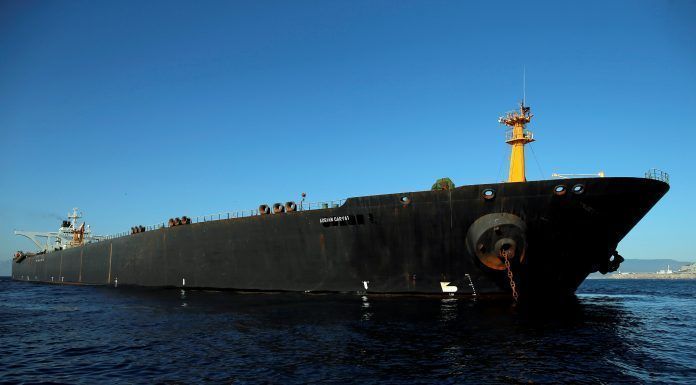By Nerijus Adomaitis and Jonathan Spicer
OSLO/ISTANBUL, Aug 30 (Reuters) – Turkey said on Friday that an Iranian oil tanker at the centre of a confrontation between Washington and Tehran was headed to Lebanon’s waters, but the United States later said the ship was sailing to Syria.
According to Refinitiv tracking data, the Adrian Darya, formerly called Grace 1, after changing course several times headed on Friday for Turkey’s Iskenderun port, 200 km (124 miles) north of Syria’s Baniyas refinery, the tanker’s suspected original destination.
When the ship was released off Gibraltar in mid-August after a five-week standoff, Iran assured Britain that the cargo was not headed to Syria.
The latest twist sets it in the direction of Syria, and raises the possibility that a ship-to-ship transfer of cargo may be attempted once it nears Lebanon’s coast.
U.S. Secretary of State Mike Pompeo said in a tweet late on Friday: “We have reliable information that the tanker is underway and headed to Tartus, Syria.”
Pompeo had earlier said that if the tanker went to Syria, Washington would take every action it could consistent with U.S. sanctions.
Turkish Foreign Minister Mevlut Cavusoglu said earlier on Friday that despite the tracking data, the tanker was “for sure” not going to Turkish ports but rather towards Lebanese waters.
Earlier on Friday, the minister told Reuters the ship was headed to Lebanon’s “main” port.
“I didn’t mean that this tanker is going to a Lebanese port, but (rather) according to the information coordinates it is heading to the territorial waters of the country,” he later told reporters at an Oslo forum.
“It doesn’t mean that it is going to reach a Lebanese port,” he said of the tanker that was carrying 2 million barrels of oil when released at Gibraltar. “We are monitoring it very closely.”
In response, Lebanese Finance Minister Ali Hassan Khalil said in a separate interview: “We have not been informed of the Iranian oil tanker Adrian Darya heading (here).”
WESTERN THREATS
The apparent confusion underlines the risk of reprisal that countries face taking in the tanker, which at 1400 GMT was headed east toward the channel separating Turkey and Cyprus after a series of turns in the Mediterranean Sea, according to tracking data.
The ship had been detained off Gibraltar due to British suspicion that it was carrying Iranian oil to Syria in violation of European Union sanctions.
[aesop_image img=”https://kayhanlife.com/wp-content/uploads/2019/08/2019-08-18T232613Z_1967989947_RC18A93F3E20_RTRMADP_3_MIDEAST-IRAN-TANKER-GIBRALTAR.jpg” panorama=”off” credit=”FILE PHOTO: The position of the Iranian oil tanker Adrian Darya 1, formerly named Grace 1, is seen on a mobile phone. REUTERS/Jon Nazca” align=”center” lightbox=”off” captionsrc=”custom” captionposition=”left” revealfx=”off” overlay_revealfx=”off”]
The United States says the tanker is controlled by the Iranian Revolutionary Guards, which it considers a terrorist group.
“What’s important here is that it is carrying oil that enables the terrorism of (President Bashar al-Assad’s) regime,” a State Department spokesperson said. The Trump administration has conveyed “our strong position via diplomatic channels to all ports in the Mediterranean that should be forewarned about facilitating” the tanker, said the spokesperson, who declined to be named.
The U.S. Treasury Department on Friday blacklisted the ship and sanctioned its captain.
Washington last year pulled out of a nuclear deal with Iran aimed at blocking its path to a nuclear bomb, and has ramped up sanctions to pressure and isolate Tehran. Iran denies ever having sought to build or acquire a nuclear weapon.
Cavusoglu told Reuters that Turkish President Tayyip Erdogan spoke about the ship’s coordinates with British Prime Minister Boris Johnson on Thursday. In a readout of the call, London said the leaders agreed it was vital to prevent Iran from acquiring a nuclear weapon but did not mention the tanker.
OPTIONS AHEAD
Shipping sources said the tanker would need to conduct a ship-to-ship transfer before being able to enter a port such as Beirut’s, which does not have deep water facilities necessary for fully laden supertankers.
It could potentially discharge its cargo offshore towards Lebanon’s Tripoli port further north, which is closer to Syria’s coastline between Lebanon and Turkey, they said. There is a ship-to-ship transfer anchorage outside of Tripoli port limits.
Beirut and Tripoli ports have both served as transhipment hubs for cargoes bound for Syria in recent years during Syria’s conflict.
An Iranian government spokesman was quoted on Monday as saying Iran had sold the oil aboard the tanker and that the vessel’s owner, whose identity he did not disclose, would decide its destination.
After its release at Gibraltar, the ship stated that its destination was the Greek port of Kalamata, then Turkey’s Mersin. On Thursday, it abruptly changed course, heading first west then south, away from the Turkish coast.
While west of Cyprus on Friday morning, it did a similar manouevre, doubling back on itself.
(Additional reporting by Laila Bassam in Beirut, Michele Kambas in Athens, Jonathan Saul in London, and Timothy Gardner and Eric Beech in Washington; Editing by Marguerita Choy and Rosalba O’Brien)



